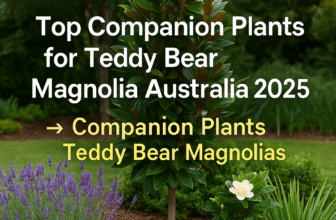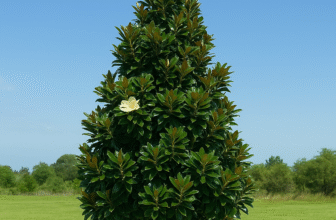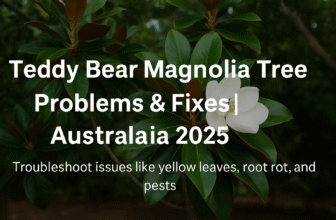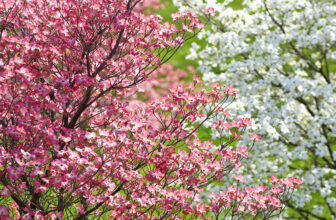Your Ultimate Guide to a Safe, Vibrant Aussie Garden!
Is Hakea Laurina Safe for Pets? Are you worried about your dog digging up plants or whether bees will thrive in your garden? Hakea Laurina, Australia’s iconic pincushion hakea, is a top pick for native gardens—but is Hakea Laurina Safe for Pets & Bees?
Yes, with a few smart tips! This guide spills the secrets to creating a pet-friendly, bee-loving garden with Hakea Laurina. Let’s dive in!

Is Hakea Laurina Toxic to Dogs or Cats? 🐾
Major pet safety databases, such as the RSPCA or ASPCA, do not list Hakea laurina as toxic to dogs or cats. It’s considered a pet-safe plant in most Australian gardens.
While it’s always best to prevent pets from chewing on garden plants, Hakea isn’t listed among the common poisonous plants like azaleas or lilies.
Large seeds or woody stems could pose a choking hazard, especially for curious puppies. If your dog cheats on branches, keep an eye on it around your Hakea.
According to the RSPCA, many Australian native plants like Hakea are not listed as toxic for dogs or cats, but supervision is still advised.
Wherever possible, this blog links to credible sources like:
- RSPCA Australia
- ASPCA Plant Toxicity Database
- CSIRO and native plant societies
These links help you double-check safety information and boost confidence in your gardening decisions. You’ll know what’s safe and what’s not from expert-backed references.
Are Hakea Laurina Leaves or Flowers Dangerous? 🌿
There’s no scientific evidence suggesting that the leaves or flowers of are Safe for Pets When touched or accidentally ingested in small amounts. They don’t contain the harmful alkaloids or glycosides in many toxic garden plants.
However, as with any garden plant, pets should be monitored for unusual symptoms after chewing foliage—vomiting or drooling can signal irritation.
Do Native Bees Like Hakea Laurina? 🐝
Yes—Hakea laurina is highly attractive to native bees. Its brush-like flowers are rich in nectar and bloom from late autumn to early spring, providing a valuable food source when other flowers are scarce.
By growing this plant, you’re actively supporting Australian pollinators.
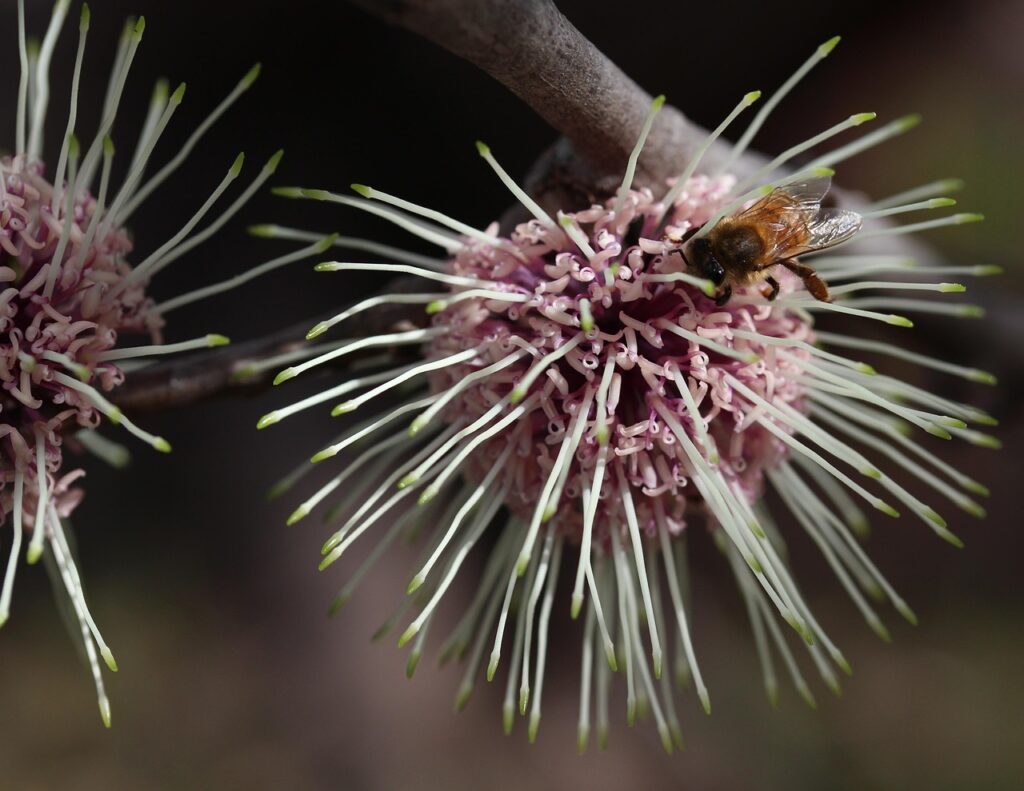
How Does Hakea Laurina Compare to Other Native Plants for Pet & Bee Safety? 🌼
- Banksia: Also pet-safe and a bee favorite, but some have sharp leaves.
- Grevillea: Gorgeous and bee-attracting, but particular species contain compounds that may irritate pets’ skin or mouths.
- Bottlebrush (Callistemon): Generally safe for pets and great for attracting bees and birds.
Hakea laurina ranks high as a balanced, safe, and attractive option for pets and pollinators.
Location-Specific Details
Australia has diverse climates and strict rules on native plants. We’ve included:
- Climate tips (e.g., Hakea laurina thrives in temperate zones like SA, WA, VIC)
- Regional guidance (e.g., WA gardeners should check biosecurity laws before planting)
- State-specific warnings or planting advice
This ensures that your gardening efforts suit your local conditions, whether in Perth, Adelaide, Sydney, or regional areas.
Quick Comparison: Hakea vs Other Native Plants
| Plant | Pet Safe? | Bee Friendly? | Notes |
|---|---|---|---|
| Hakea laurina | Yes | Yes | Hardy, non-toxic, autumn blooms |
| Grevillea spp. | Caution | Yes | Some varieties may irritate dogs |
| Banksia spp. | Yes | Yes | Safe but may attract possums |
| Bottlebrush (Callistemon) | Yes | Yes | Popular bee plant, safe for pets |

Tips to Keep Your Garden Pet-Safe 🐶🌸
Is Hakea Laurina safe for pets? It’s a common question among Aussie pet owners.
- Place Hakea laurina in areas where pets don’t dig or chew.
- Avoid using chemical pesticides on or near your native plants.
- Mulch with natural materials that are non-toxic.
- Train pets to stay away from garden beds using gentle reinforcement.
How About Bees and Pollinators? 🐝🌼
Hakea laurina is a fantastic plant for native bees, butterflies, and birds. Its pincushion flowers are rich in nectar and bloom in autumn and winter when food is scarce for pollinators.
Unlike non-native ornamentals, Hakea supports biodiversity and won’t harm visiting bees.
Bonus: The dense shrub also provides shelter for small birds like honeyeaters.
Which Aussie Pets Might Interact with Hakea?
Australian homes often include more than just cats and dogs. If you keep:
- Budgies or parrots may nibble leaves, but usually ignore woody shrubs like Hakea.
- Backyard chickens: Hakea isn’t known to harm chickens. Plus, it’s too woody and tough for them to eat much.
- Outdoor rabbits or guinea pigs: Rarely show interest, but monitor nibbling if they’re nearby
Interesting Facts 🌱
- Due to its low toxicity, Hakea laurina is often planted in bushland restoration projects.
- The plant’s rigid structure deters most animals from chewing.
- It’s a magnet for birds, bees, and butterflies, turning your yard into a pollinator haven.
Our Related Searches
Click to learn Is Hakea is safe for pets & bees. Dog-friendly gardening guide 2025
Step by Step Guide to Growing Hakea Laurina from Seed, Australia 2025
Why Is My Hakea Laurina Not Flowering? Common Problems & Easy Fixes in Australia
Hakea Laurina Care in Australia: The Complete Growing & Landscaping Guide (2025)
Common Hakea Laurina Problems in Australia & How to Fix Them (Yellow Leaves, Pests & More)
Final Thoughts 🌼
Many Australian gardeners ask, “Is Hakea Laurina safe for pets like dogs and cats?” especially when landscaping dog-friendly spaces.
Hakea laurina is one of the safest and most beautiful native plants for Aussie gardeners with pets. It doesn’t pose serious risks to dogs or cats and greatly benefits native bees. If you’re looking to create a garden that’s safe, sustainable, and full of color, this plant is a great choice.
Looking to grow it from seed? Check out our guide: How to Grow Hakea Laurina from Seed in Australia (2025)
Tap to learn our Comprehensive care and growing guide, Hakea Laurina care in Australia, A complete growing guide 2025
So, is Hakea Laurina safe for pets? Yes, in most cases, but constantly monitor pets and refer to vet or RSPCA guidelines if unsure.
Our deep searches on native Australian plants and shrubs
Click here to visit another page: “Why Is My Banksia Dying? A Comprehensive Guide 2025”
Small Banksia for a tiny Garden: learn easy care tips and tricks Guide 2025
Why are my Grevilleas not flowering in Australia?
Small Banksias for Tiny Gardens & Pots: Easy-Care Australian guide 2025
How to Grow Banksia from Seed in Australia: An Easy Guide 2025 – Anyone Can Do It!
Banksia and Grevillea Pests: How to Spot and Stop Them Naturally + Pet Safety Guide 2025
FAQs About Hakea Laurina & Pet Safety in Australia
Q1: Is Hakea laurina poisonous to dogs?
A: No, it is not listed as toxic to dogs in Australia.
Q2: Can cats chew on Hakea leaves?
A: It’s best to prevent it, but Hakea leaves are not considered harmful in small quantities.
Q3: Will bees be attracted to Hakea in winter?
A: Hakea laurina flowers from late autumn to early spring are perfect for feeding winter-active pollinators.
Q4: Are the flowers safe for children to touch?
A: Yes, the blooms are safe and non-toxic. Just avoid letting kids eat plant parts.
Q5: What should I do if my dog chews a Hakea seed pod?
A: Monitor for choking or digestive upset. Seed pods are woody but not toxic.
Q6: Can I plant Hakea near a bee-friendly vegetable garden?
A: Absolutely! It attracts bees and helps with pollination in nearby plants.
Q7: Does Hakea Laurina need special care to stay pet-safe?
A: No special care—just basic gardening hygiene like avoiding pesticides and trimming woody branches.


